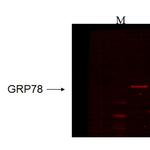Search Thermo Fisher Scientific
FIGURE: 1 / 2
GRP78 Antibody (MA5-45282) in ICC/IF


Product Details
MA5-45282
Species Reactivity
Host/Isotype
Class
Type
Clone
Immunogen
Conjugate
Excitation/Emission Max
Form
Concentration
Purification
Storage buffer
Contains
Storage conditions
Shipping conditions
RRID
Product Specific Information
0.5 µg/mL of MA5-45282 was sufficient for detection of Grp78 in 10 µg of HeLa cell lysate by ECL immunoblot analysis.|Detects approximately 78kDa.
Target Information
GRP78 is a 78 kDa glucose regulated protein that belongs to the family of heat shock proteins that include HSP70. GRP78 is a resident protein of the endoplasmic reticulum (ER) and associates transiently with a variety of newly synthesized secretory and membrane proteins. GRP78 may also interact with mutant and misfolded proteins, marking them for degradation. The highly conserved sequence Lys-Asp-Glu-Leu (KDEL) is present at the C-terminus of GRP78 and other resident ER proteins including glucose regulated protein 94 (GRP94) and protein disulfide isomerase (PDI). The KDEL signal is recognized by the KDEL receptor and this interaction ensures recycling of escaped ER proteins back to the ER. GRP78’s involvement in correct folding of proteins and degradation of misfolded proteins is via its interaction with DNAJC10, probably to facilitate the release of DNAJC10 from its substrate. GRP78 is critical for maintenance of cell homeostasis and the prevention of apoptosis. GRP78 protein levels have been shown to be a reliable biomarker of hypoglycemia and serves a neuroprotective function in neurons exposed to glutamate and oxidative stress. GRP78 levels are reduced in the brains of Alzheimer's Disease patients, and decreased expression of GRP78 is found associated with missense mutations in the human presenilin-1 (PS1) gene. Further, the induction of the GRP78 protein has been associated with the development of drug-resistance to antitumor drugs.
For Research Use Only. Not for use in diagnostic procedures. Not for resale without express authorization.
References (0)
Bioinformatics
Protein Aliases: 78 kDa glucose-regulated protein; Binding-immunoglobulin protein; BiP; BiP protein; Endoplasmic reticulum chaperone BiP; endoplasmic reticulum lumenal Ca(2+)-binding protein grp78; epididymis secretory sperm binding protein Li 89n; FLJ26106; glucose regulated protein, 78 kDa; glucose-regulated protein; glucose-regulated protein, 78kDa; GRP 78; GRP-78; heat shock 70 kDa protein 5; heat shock 70 kDa protein 5a; heat shock 70kD protein 5; heat shock 70kD protein 5 (glucose-regulated protein, 78kD); heat shock 70kDa protein 5 (glucose-regulated protein); heat shock 70kDa protein 5 (glucose-regulated protein, 78kDa); heat shock protein 5; Heat shock protein 70 family protein 5; Heat shock protein family A member 5; heavy-chain binding protein BiP; HSP70 family protein 5; HSPA 5; immunoglobulin binding protein; Immunoglobulin heavy chain-binding protein; Steroidogenesis-activator polypeptide; XAP-1 antigen
Gene Aliases: AL022860; AU019543; baffled; BIP; BiP/Grp78; D2Wsu141e; D2Wsu17e; GRP78; HEL-S-89n; Hsce70; HSPA5; hspa5a; I79_019946; mBiP; MIF2; SEZ-7; Sez7; XAP-1; XELAEV_180384511mg
UniProt ID: (Bovine) Q0VCX2, (Human) P11021, (Rat) P06761, (Mouse) P20029, (Chinese hamster) G3I8R9, (Xenopus) Q91883
Entrez Gene ID: (Rabbit) 100008764, (Bovine) 415113, (Human) 3309, (Rat) 25617, (Mouse) 14828, (Chinese hamster) 100689305, (Xenopus) 397850

Performance Guarantee
If an Invitrogen™ antibody doesn't perform as described on our website or datasheet,we'll replace the product at no cost to you, or provide you with a credit for a future purchase.*
Learn more
We're here to help
Get expert recommendations for common problems or connect directly with an on staff expert for technical assistance related to applications, equipment and general product use.
Contact tech support

